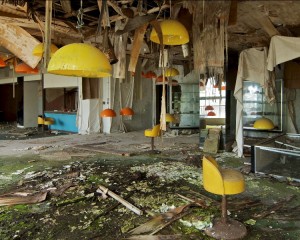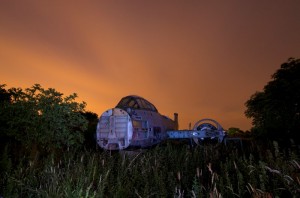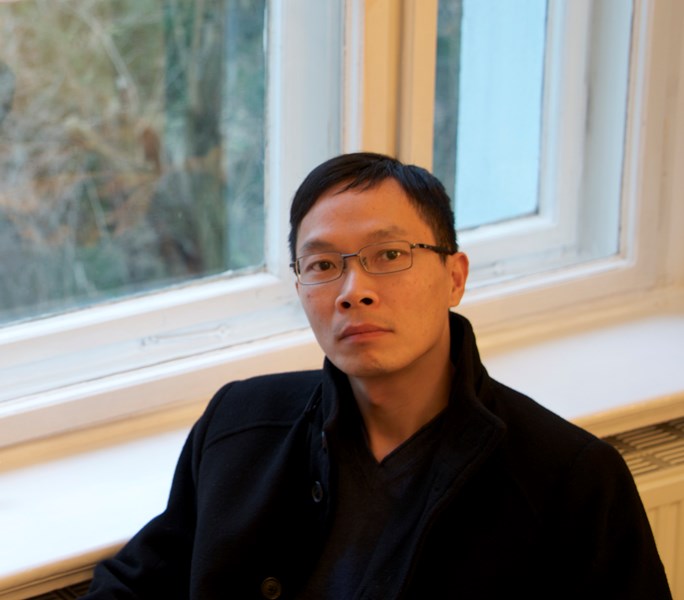by Sabrina Boasman
What will the end look like? Historian, author, and visual artist, Tong Lam an Associate Professor of History at the University of Toronto, answers this question in a provocative new project called Abandoned Futures.
 Abandoned Futures is a breathtaking global overview of the decay and abandonment that sits in the midsts of humanities constant push towards an uncertain future. It’s a visual epic dedicated to the edge of our power, where human industry fails and decay takes over. These are the landscapes that give the lie to our dreams of immortality. Abandoned Futures is a roadtrip into a post-apocalyptical landscape that is at turns both beautiful and frightening. It features striking imagery from different continents: from the futuristic island that forms the base of James Bond’s nemesis in Skyfall to a sinister abandoned theme park in USA. Witness the despair of crumbling industrial Detroit and the spectre of failed modernism in a deserted space age village in Taiwan.
Abandoned Futures is a breathtaking global overview of the decay and abandonment that sits in the midsts of humanities constant push towards an uncertain future. It’s a visual epic dedicated to the edge of our power, where human industry fails and decay takes over. These are the landscapes that give the lie to our dreams of immortality. Abandoned Futures is a roadtrip into a post-apocalyptical landscape that is at turns both beautiful and frightening. It features striking imagery from different continents: from the futuristic island that forms the base of James Bond’s nemesis in Skyfall to a sinister abandoned theme park in USA. Witness the despair of crumbling industrial Detroit and the spectre of failed modernism in a deserted space age village in Taiwan.
This photo essay book contains highly accessible short essays and numerous full-color images. It is a visual ethnography of industrial and postindustrial ruins from Asia, North America, and Europe. Above all, it is a meditation on the issues of time, modernity, and civilization.
About Tong Lam: Tong’s research interests cover modern and contemporary China and East Asia, modernity, technoscience, spectacle and urbanism, social theory, colonialism, and nationalism. As a visual artist, he is particularly interested in using photographic and cinematographic techniques to explore and examine industrial and postindustrial ruins from around the world, as well as China’s hysterical transformation. Lam received his PhD in History from the University of Chicago and is an Associate Professor of History at the University of Toronto.
L’Etage Magazine recently had the opportunity to interview Lam about this project and what inspires him.
L’Etage: What initially inspired you to do this project?
Tong Lam: Some years ago, when I started shooting night photos in an abandoned car junkyard in southern California, I was stuck by the numerous abandoned motels, gas stations, roadside cafes, theme parks, and ghost towns scattering across the desert. Together with the ever proliferating images of Detroit’s urban blight in the media, these scenes of abandonment and decay associated with cars gave me an idea of photographing the landscape of car-related ruins, from the birthplace of cars to their graveyards and everything else along the highways. Such a project, a sort of an elegy for a carefree car culture, would be polemical and symbolic at once since cars were very central to the American civilization in the last century.
But as soon as I began to visit Detroit, other ideas sprung up quickly. For instance, while there were no shortage of photo essays and documentary films about Detroit these days, I often found them unsatisfactory because they tended to approach a single city or region in isolation. If the decline of the American Rust Belt cities such as Detroit and Buffalo is a product of globalization, then we need to track the story globally. That led me to the idea of creating a visual poem to dissect the modern ruinscapes around the world. As it is, the book includes images from East Asia, North America, and Western Europe. And the original project on car-related ruins also became a chapter.
L’Etage: How did you come up for the title of the book?
Tong Lam: Aside from being a visual artist, I’m also a historian by trade. Therefore, I’m always fascinated with the paths not taken by us. For me, these ruinous places are signs of the failed ambitions, hopes, and dreams. As such, “Abandoned Futures” seems to be the right title to convey the melancholic melody of these betrayed promises. It also reminds us that the past is made up of alternatives and missed opportunities.
L’Etage: What is the main thing you want readers to take away from this?
Tong Lam: I hope readers of the book do not just consume these images passively, but think actively about the consequences of our actions and lifestyle. In other words, I hope these haunting images will compel readers to contemplate the precarious condition of our existence.
 L’Etage: How connected is this book to your personal outlook on humanity?
L’Etage: How connected is this book to your personal outlook on humanity?
Tong Lam: Cities always like to showcase their beautiful places such as slimmer skyscrapers and heritage districts. Meanwhile, the industrial and postindustrial ruins that I seek to capture have often been forgotten even by the locals. I’m neither an optimist nor pessimist, and I think we have the capacity to create as well as to destroy. But if we want to have a sustainable development, we need to take drastic corrective action now. I hope this book; in a humble way at least, will help us to acknowledge the devastation and waste left behind by our modern civilization.
L’Etage: How do you think people across various generations would relate to this book? Do you think it will be viewed in a different light by a younger person vs. an older person?
Tong Lam: In the process of photographing these ruined places, I have spoken with many people who are attracted to this kind of images. I think older people are emotionally connected to these images because they often have some experiences and memories of similar places. For example, I have encountered quite a few older people who told me stories of abandoned schools that they had once attended or decommissioned factories that their parents had worked for a long time. In contrast, most young people think places like these are “cool” and exotic, and their sense of nostalgia is more abstract. In general, I think people tend to respond to these images differently due to their gender, class, and other background experiences. Still, in this book, I hope readers will go beyond the haunting images and think about the urgent social and environmental problems that we face collectively.
L’Etage: What was the hardest and easiest part about putting this project together?
Tong Lam: The biggest challenge for me was to strike a balance between presenting arresting images to the audience and inviting them to think critically about the contexts behind these images. It is my hope that these images do not simply perpetuate another cycle of passive image consumption, and I think the succinct writing will do some of the tricks. At the same time, once I started the project, I realized that there were so many ways that I could connect these seemingly dissimilar and faraway sites. As a researcher on modern history, urban space, and globalization, I simply have no shortage of topics and approaches to bring these diverse locations together. So, even though other photographers have often neglected those issues, it is rather easy for me to find meaningful ways to connect these places.
 L’Etage: What did you find most surprising? Did you learn something about yourself during this process?
L’Etage: What did you find most surprising? Did you learn something about yourself during this process?
Tong Lam: Although I try to approach these abandoned places from a more critical perspective, I find myself also drawn to the aesthetics of these modern ruins. In a sense, it is not always easy to be a critical observer and ruin enthusiast the same time. Nevertheless, I think that tension has been quite productive for me.
L’Etage: How delicate are great empires of the world?
Tong Lam: Historically, the strength of great empires is always rested on their ability to incorporate different elements into one single political entity, often at a great price. Because of their inherent heterogeneous nature, when an empire crumbles, they often do so very quickly. So, yes, these modern ruins can be read allegorically as the story of the inevitable collapse of great empires and civilizations. Nonetheless, civilizations capable of critically reflecting on its existence are more likely to prevail for a longer time.


